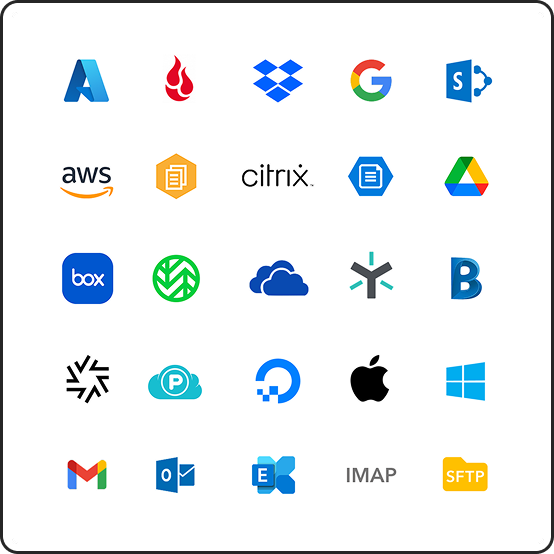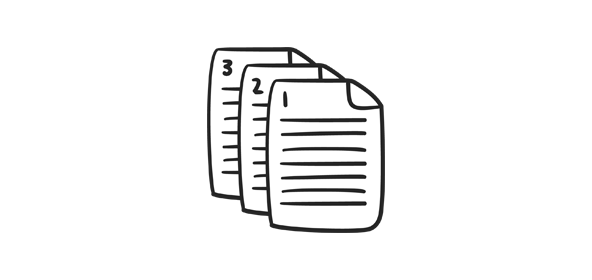When doing a data migration, it's important that all of your critical files arrive. And quickly. One of the most important ways to make sure your project is a success is to use a good data migration tool. And that's where Movebot comes in. If you're looking at how to migrate from Egnyte to Dropbox, it's easy with Movebot. All you have to do is follow our three-step PAC migration process and you'll be ready to start moving in no time.

Egnyte vs Dropbox
Egnyte and Dropbox are both cloud storage platforms with a widespread user base. While both can store files and have several collaboration features, they focus on different things, which can make one choice the better option depending on the specific needs of the organization.
What is Egnyte?
Aiming to be "the all-in-one content, security, and governance platform", Egnyte acts like a traditional file server but in the cloud. It has a number of features to help with organization, security, and collaboration such as shared links, finding potential malware, and the ability to create workflows and tasks.
Beyond collaboration, Egnyte helps organizations meet many strict compliance guidelines such as GDPR, ISO 27001, and GxP. With specialists across many industries including ad agencies and publishers, life sciences, and financial services, organizations in these industries can chat with an expert before signing up to learn in detail how Egnyte meets their requirements.
Egnyte has invested heavily in AI, creating a private, purposeful, and practical AI that meets governance models and respects user permissions. The AI can help find, summarize, and classify documents, with no tools or special skills needed to use it. This can greatly streamline operations and help users find what they need, when they need it.
About Dropbox
Dropbox is a file hosting and cloud storage provider focusing on collaboration. It enables users to access content no matter where they are and the sync feature makes sure files in the cloud are always up to date. Dropbox continues to add new collaboration features including Dropbox Paper for real-time simultaneous document editing and Dropbox Replay for media approval.
As one of the largest players in cloud storage, Dropbox has created a fast, efficient, and affordable cloud storage model. Business plans start at $15/user/month, with additional costs for more storage. On the Enterprise tier, organizations get enterprise-grade security with live support from experts and a customizable storage amount.
Collaboration is a core component of Dropbox, and they continue adding features so users can do more without ever having to leave Dropbox. Now users can enhance and find images (based on the content of the images by utilizing AI), make notes on videos, and edit PDFs all within Dropbox, making storage and collaboration easier than ever.
Dropbox and Egnyte limitations
When looking to migrate from Egnyte to Dropbox, there are a few things to keep in mind to make sure everything will be moved over properly. Fortunately, Movebot can handle most of these limitations automatically.
Every storage platform handles data differently, and as a result, some things that are possible or even normal in one platform won't work in another. When these are small things like unusable characters in filenames, a data migration tool like Movebot can take care of it automatically. Simply keep filename sanitization enabled and Movebot will fix bad filenames during the migration without you having to do a thing.
Hard limitations, however, are a different story. File size, for instance, is something that can't easily be changed without drastically altering the file. And no matter what changes you make, if you have a single file above the maximum filesize limit it simply won't be possible to have it in the storage account. Fortunately, Dropbox has some of the most generous file sizes available, with a maximum of 2TB per file when uploaded via the Desktop or Mobile app, so this shouldn't be an issue when migrating Egnyte to Dropbox.
Egnyte and Dropbox have similar limits for sharing and folder structure. Both allow for 50,000 files in a folder and 50,000 sub-folders. Dropbox has a higher file path limit, so this won't be a problem when migrating from Egnyte. One possible situation that could come up has to do with permissions. Dropbox has a maximum of 1000 members that can belong to a group, team folder, or shared folder. Egnyte doesn't document any maximums, so this could potentially be an issue for objects that are widely shared and would require removing some users or restructuring the data to fit.
How to migrate from Egnyte to Dropbox with Movebot
Because of the similarities in restrictions and architecture, moving from Egnyte to Dropbox is simple with Movebot. All you have to do is follow our 3-step PAC migration plan and you'll be packed for success for your big move.
Plan
Every successful journey starts with a plan, and migrations are no different. However, when you use Movebot, planning doesn't involve downloading applications on virtual machines, managing infrastructure, and starting the transfer at 5:01PM on the Friday of a long weekend to avoid disrupting workers.
Movebot was designed to be fast, simple, and reliable, and that includes planning and setup too. Instead of the above, planning can involve deciding what files to move, if you want to rename any existing files in bulk, and where you want data processing to take place.
To start your migration, you'll need to connect both Dropbox and Egnyte to Movebot. Fortunately, they're both relatively simple. To connect, log in to Movebot and choose to create a new connection. For Dropbox, choose Dropbox Personal or Dropbox Business. For Egnyte, choose Egnyte. Then follow the prompts to connect via OAuth. We recommend connecting to both accounts as an Admin to make sure you have permission to view and copy files, which will be required for the migration.
With the accounts connected, you can decide if there are certain files you don't want to include in the migration. Use Movebot filtering to isolate files based on a combination of filename, last modification time, and more. You can then choose to move those files somewhere else like an archival platform, or simply don't move them at all and delete them later on.
The default options for Movebot give the best results in the majority of migration projects, but you can update them if you need to make changes to the settings based on the organization's needs. Once you go through the settings, choose if there's anyone you want to notify about when a transfer finishes, and update your data processing region if you need to.
Now it's time to move on to the next stage.
Advance
With the project set up, it's time to start moving data in the Advance stage. This is also a little different in Movebot. You don't have to move the entire source to the destination; instead, you can map transfers down to the deepest subfolder. Each folder mapped counts as one transfer, and each transfer is controlled by you--run them when and how you want. You can run unlimited transfers without a change in cost (you only pay for the amount of data you move and that's it), so make as many transfers as you want.
Whenever a transfer is running, you'll have access to the performance tracker that gives you live stats about the transfer. Here you can see how many files and amount of data moved, as well as if there were any issues along the way. A few peaks and valleys are normal, but if you notice that your transfer seems to be consistently performing worse than expected, feel free to contact Movebot Support and someone will take a look and see if anything is going on.
Cutover
Once most of the data is moved from Egnyte to Dropbox, it's time for the Cutover stage to make sure you have everything you need. Whenever a transfer finishes, Movebot will generate a post-transfer report with stats about the transfer like the amount of data moved and if there were any failures. A few failures are normal, and you can use delta migrations to grab both failures and any new/updated files.
Delta migrations in Movebot work a bit differently as well. Because Movebot copies files instead of moving them, the source file itself is never altered. So when a user updates a file, even while a migration is in progress, it won't affect the transfer. How delta migrations work with Movebot is that the source and destination are analyzed and any files that are new or newer in the source are moved and nothing else. This includes any updates that users made while the migration was running.
Keep running deltas until you have all the data you need and that's it! PAC is done and you're all moved over to the Dropbox account.
Try an easier way to migrate from Egnyte to Dropbox
Moving from Egnyte to Dropbox is simple with Movebot. With no infrastructure to manage or maintain, unmatched transfer speeds, and everything managed in the intuitive web interface, migrations have never been easier.
But you don't have to trust us on that. Try Movebot and see for yourself how straightforward can be. Every new account gets a free trial automatically, with no credit card required. Simply sign up, connect platforms, and see if Movebot is right for you. Register for an account now to get started.






